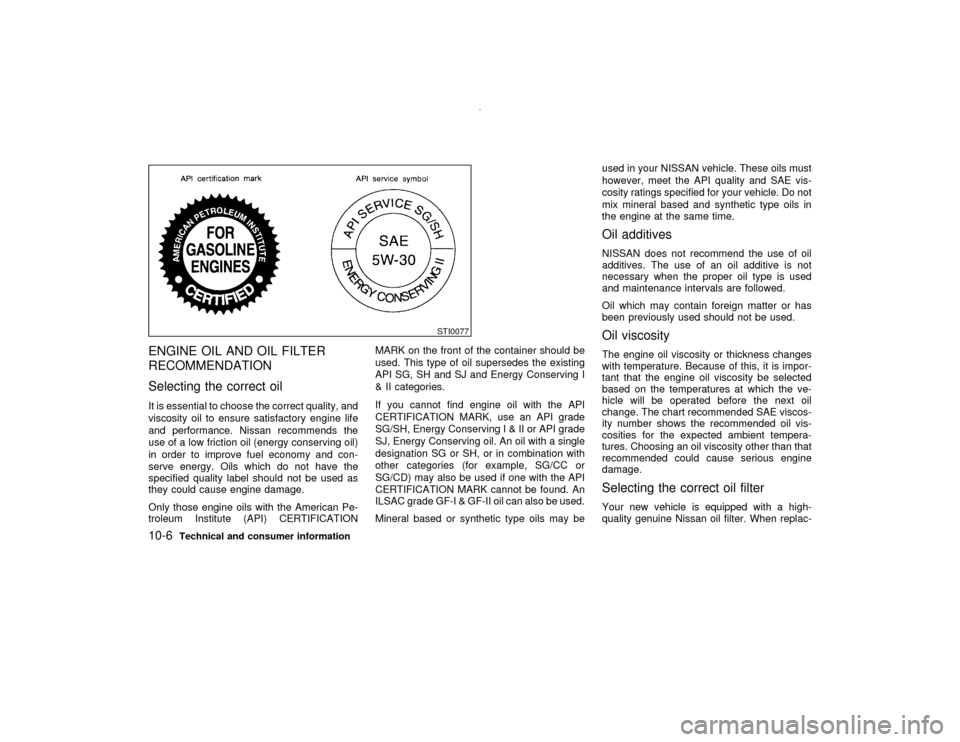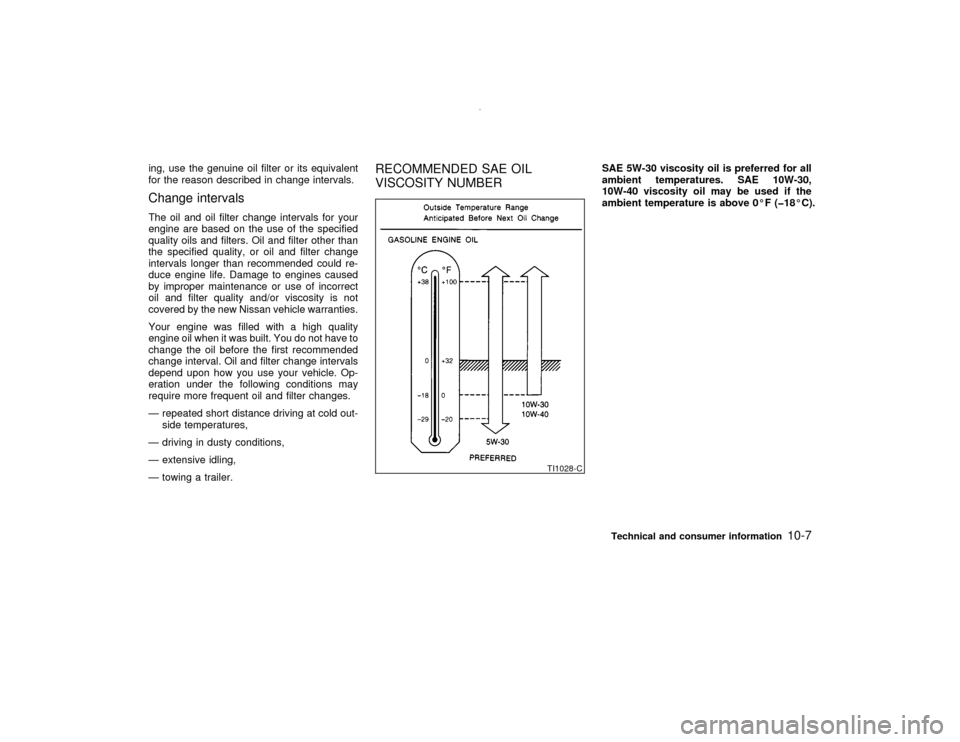2001 NISSAN PATHFINDER maintenance
[x] Cancel search: maintenancePage 261 of 289

ENGINE OIL AND OIL FILTER
RECOMMENDATION
Selecting the correct oilIt is essential to choose the correct quality, and
viscosity oil to ensure satisfactory engine life
and performance. Nissan recommends the
use of a low friction oil (energy conserving oil)
in order to improve fuel economy and con-
serve energy. Oils which do not have the
specified quality label should not be used as
they could cause engine damage.
Only those engine oils with the American Pe-
troleum Institute (API) CERTIFICATIONMARK on the front of the container should be
used. This type of oil supersedes the existing
API SG, SH and SJ and Energy Conserving I
& II categories.
If you cannot find engine oil with the API
CERTIFICATION MARK, use an API grade
SG/SH, Energy ConservingI&IIorAPIgrade
SJ, Energy Conserving oil. An oil with a single
designation SG or SH, or in combination with
other categories (for example, SG/CC or
SG/CD) may also be used if one with the API
CERTIFICATION MARK cannot be found. An
ILSAC grade GF-I & GF-II oil can also be used.
Mineral based or synthetic type oils may beused in your NISSAN vehicle. These oils must
however, meet the API quality and SAE vis-
cosity ratings specified for your vehicle. Do not
mix mineral based and synthetic type oils in
the engine at the same time.
Oil additivesNISSAN does not recommend the use of oil
additives. The use of an oil additive is not
necessary when the proper oil type is used
and maintenance intervals are followed.
Oil which may contain foreign matter or has
been previously used should not be used.Oil viscosityThe engine oil viscosity or thickness changes
with temperature. Because of this, it is impor-
tant that the engine oil viscosity be selected
based on the temperatures at which the ve-
hicle will be operated before the next oil
change. The chart recommended SAE viscos-
ity number shows the recommended oil vis-
cosities for the expected ambient tempera-
tures. Choosing an oil viscosity other than that
recommended could cause serious engine
damage.Selecting the correct oil filterYour new vehicle is equipped with a high-
quality genuine Nissan oil filter. When replac-
STI0077
10-6
Technical and consumer information
Z
00.1.10/R50-D/V5
X
Page 262 of 289

ing, use the genuine oil filter or its equivalent
for the reason described in change intervals.Change intervalsThe oil and oil filter change intervals for your
engine are based on the use of the specified
quality oils and filters. Oil and filter other than
the specified quality, or oil and filter change
intervals longer than recommended could re-
duce engine life. Damage to engines caused
by improper maintenance or use of incorrect
oil and filter quality and/or viscosity is not
covered by the new Nissan vehicle warranties.
Your engine was filled with a high quality
engine oil when it was built. You do not have to
change the oil before the first recommended
change interval. Oil and filter change intervals
depend upon how you use your vehicle. Op-
eration under the following conditions may
require more frequent oil and filter changes.
Ð repeated short distance driving at cold out-
side temperatures,
Ð driving in dusty conditions,
Ð extensive idling,
Ð towing a trailer.
RECOMMENDED SAE OIL
VISCOSITY NUMBER
SAE 5W-30 viscosity oil is preferred for all
ambient temperatures. SAE 10W-30,
10W-40 viscosity oil may be used if the
ambient temperature is above 0ÉF (þ18ÉC).
TI1028-C
Technical and consumer information
10-7
Z
00.1.10/R50-D/V5
X
Page 264 of 289

ENGINE
Model VQ35DE VG33E
Type Gasoline, 4-cycle Gasoline, 4-cycle
Cylinder arrangement 6-cylinder, V-slanted at 60É 6-cylinder, V-slanted at 60É
Bore´Stroke in (mm) 3.760´3.205 (95.5´81.4) 3.602´3.268 (91.5´83.0)
Displacement
cu in (cm
3)213.45 (3,498) 199.84 (3,275)
Firing order 1-2-3-4-5-6 1-2-3-4-5-6
Idle speed rpm
See the ªEmission control
labelº on the underside of the hood.See the ªEmission control
labelº on the underside of the hood. Ignition timing (BTDC)
degree/rpm
CO percentage at idle speed
[No air] %
Spark plug PL FR5A-11 (Standard) FR4AP-10 (Hot)
PL FR4A-11 (Service option) FR5AP-10 (Standard)
PL FR6A-11 (Service option) FR6AP-10 (Cold)
Spark plug gap in (mm) 0.043 (1.1) 0.039 (1.0)
Camshaft operation Timing chain Timing belt*1
Alternator belt size
Width´Length
in (mm)0.8409´46.26 (21.36´1,175) 0.8409´41.93 (21.36´1,065)
*1: Periodic maintenance is necessary. See ªPeriodic maintenanceº in the ª9. Maintenanceº section for maintenance intervals.
SPECIFICATIONS
Technical and consumer information
10-9
Z
00.1.10/R50-D/V5
X
Page 275 of 289

However, for long steep grades, do not stay in
1st or 2nd gear when driving above 35 MPH
(56 km/h).
IIf the engine coolant rises to an extremely
high temperature when the air conditioning
system is on, turn off the air conditioner.
Coolant heat can be additionally vented by
opening the windows, switching the fan
control to high and setting the temperature
control to the HOT position.
ITrailer towing requires more fuel than nor-
mal circumstances.
IAvoid towing a trailer for the first 500 miles
(800 km).
IHave your vehicle serviced more often than
at intervals specified in the recommended
Maintenance Schedule.
When towing a trailer, change oil in the
transmission more frequently. See the
Maintenance Schedule.UNIFORM TIRE QUALITY
GRADINGDOT (Department of Transportation) Quality
Grades: All passenger car tire must conform to
Federal Safety Requirements in addition to
these grades.Quality grades can be found where applicable
on the tire sidewall between tread shoulder
and maximum section width. For example:
Treadwear 200 Traction AA Temperature A
TreadwearTreadwear grade is a comparative rating
based on tire wear rate when tested under
controlled conditions on specified government
test courses. For example, a tire graded 150
would wear one and a half (1-1/2) times as well
on the government course as a tire graded
100. However, relative tire performance de-
pends on actual driving conditions, and may
vary significantly due to variations in driving
habits, service practices and differences in
road characteristics and climate.Traction AA, A, B and CThe traction grades from highest to lowest are
AA, A, B, and C. Those grades represent the
tire's ability to stop on wet pavement as mea-
sured under controlled conditions on specified
government test surfaces of asphalt and con-
crete. A tire marked C may have poor traction
performance.
WARNING
The traction grade assigned to your ve-
hicle tires is based on straight-ahead
braking traction tests, and does not in-
clude acceleration, cornering, hydro-
planing, or peak traction characteristics.Temperature A, B and CTemperature grades are A (the highest), B,
and C. They represent a tire's resistance to
heat build-up, and its ability to dissipate heat
when tested under controlled conditions on a
specified indoor laboratory test wheel. Sus-
tained high temperature can cause tire mate-
rial to degenerate, reducing tire life. Excessive
temperatures can lead to sudden tire failure.
Grade C corresponds to a performance level
which all passenger car tires must meet under
the Federal Motor Vehicle Safety Standard No.
109. Grades A and B represent higher levels of
performance on laboratory test wheels than
the minimum required by law.
10-20
Technical and consumer information
Z
00.1.10/R50-D/V5
X
Page 277 of 289

You may notify NISSAN by contact-
ing our Consumer Affairs Depart-
ment, toll-free, at 1-800-NISSAN-1.
In Hawaii call (808) 836-0888.
Due to legal requirements in some states/
areas, your vehicle may be required to be in
what is called the ready condition for an
Inspection/Maintenance (I/M) test of the emis-
sion control system.
The vehicle is set to the ready condition when
it is driven through certain driving patterns.
Usually, the ready condition can be obtained
by ordinary usage of the vehicle.
If a powertrain system component is repaired
or the battery is disconnected, the vehicle may
be reset to a not ready condition. Before taking
the I/M test, drive the vehicle through the
following pattern to set the vehicle to the ready
condition. If you cannot or do not want to
perform the driving pattern, an NISSAN dealer
can conduct it for you.
WARNING
Always drive the vehicle in a safe and
prudent manner according to traffic con-
ditions, and obey all traffic laws.
1. Start the engine when the engine coolant
temperature gauge needle points to C. Al-
low the engine to idle until the gauge needlepoints between the C and H (normal oper-
ating temperature).
2. Accelerate the vehicle to 55 MPH (88
km/h), then quickly release the accelerator
pedal completely and keep it released for at
least 6 seconds.
3. Quickly depress the accelerator pedal for a
moment, then drive the vehicle at a speed
of 53 to 60 MPH (86 to 96 km/h) for at least
5 minutes.
4. Stop the vehicle.
5. Accelerate the vehicle to 35 MPH (55 km/h)
and maintain the speed for 20 seconds.
6. Repeat steps 4 and 5 at least 3 times.
7. Accelerate the vehicle to 55 MPH (88 km/h)
and maintain the speed for at least 3 min-
utes.
8. Stop the vehicle (shift lever in the ªPº or ªNº
position).
9. Rev the engine up between 2,500 and
3,500 rpm and hold it for 3 consecutive
minutes, then release the accelerator pedal
completely.
10.Wait 5 second at idle.
11.Rev the engine up between 2,000 andREADINESS FOR INSPECTION/
MAINTENANCE (I/M) TEST (US
only)
10-22
Technical and consumer information
Z
00.1.10/R50-D/V5
X
Page 278 of 289

3,000 rpm and maintain it for 5 consecutive
minutes.
12.Turn the engine off.
13.Repeat steps 1 through 8 at least one more
time.
If step 1 through 7 is interrupted, repeat the
preceding step. Any safe driving mode is ac-
ceptable between steps. Do not stop the en-
gine until step 7 is completed.
Dynamometer testing for Inspection/
Maintenance (I/M) test (US only)Due to legal requirements in some
states/areas, your vehicle may be tested for
emissions on a dynamometer. The transfer
control lever (if so equipped) MUST be in the
2H position for I/M testing on a two wheel
dynamometer.
WARNING
IIf the transfer control lever is not in
the 2H position during the dynamom-
eter I/M testing, the vehicle could
come off the dynamometer and cause
serious personal injury and/or body
damage to the vehicle.ISerious damage will occur to the
4WD system if the transfer control
lever is not in the 2H position.
Technical and consumer information
10-23
Z
00.1.10/R50-D/V5
X
Page 284 of 289

Capacities and recommended fuel/
lubricants ................................................... 10-2
Engine coolant............................................. 8-6
Engine oil................................................... 8-10
Power steering fluid................................... 8-15
Window washer fluid ................................. 8-17
Fog light switch ............................................... 2-22
4WD shift switch operations ........................... 5-26
Four wheel drive (4WD) ........................ 5-20, 5-23
Front air bag system (See supplemental restraint
system) ........................................................... 1-16
Front fog light switch ...................................... 2-23
Front manual seat adjustment .......................... 1-2
Front power seat adjustment ............................ 1-4
Fuel
Capacities and recommended fuel/
lubricants ................................................... 10-2
Filler cap .................................................... 3-12
Filler lid ...................................................... 3-12
Filler lid and cap ........................................ 3-12
Filler lid opener lever................................. 3-12
Fuel economy ............................................ 5-19
Fuel octane rating ..................................... 10-4
Fuel recommendation................................ 10-4
Gauge .......................................................... 2-5
Fuses .............................................................. 8-24
Fusible links .................................................... 8-25
G
Garage door opener, Integrated HomeLink
Universal Transceiver ..................................... 2-40
Gas cap .......................................................... 3-12
Gauge ............................................................... 2-3Engine coolant temperature gauge ............. 2-4
Fuel gauge .................................................. 2-5
Odometer..................................................... 2-3
Speedometer ............................................... 2-3
Tachometer ................................................. 2-4
General maintenance ....................................... 9-2
Glass hatch and outside mirror defogger
switch .............................................................. 2-19
Glass hatch lock ............................................. 3-11
Glass hatch opener ........................................ 3-11
Glasses case .................................................. 2-27
Glove box........................................................ 2-29
Glove box lock ................................................ 2-29
H
Hazard warning flasher switch........................ 2-23
Head restraints ................................................. 1-9
Headlamps, (Bulb replacement) ..................... 8-28
Headlights
(Bulb replacement) .................................... 8-28
Headlight switch ........................................ 2-19
Heated seats................................................... 2-24
Heater
Engine coolant heater ............................... 5-35
Heater and air conditioner (automatic) (if so
equipped)..................................................... 4-8
Heater and air conditioner controls ............. 4-2
Heater operation.......................................... 4-2
HomeLink
Universal Transceiver .................. 2-40
Hood, release ................................................... 3-9
Hook, Luggage hook ...................................... 2-31
Horn ................................................................ 2-24
How to stop alarm, Vehicle security ............... 2-16I
Ignition switch ................................................... 5-6
Automatic transmission models .................. 5-6
Key positions ............................................... 5-8
Manual transmission models....................... 5-7
Immobilizer system ......................................... 2-16
Indicator lights and chimes (See warning/indicator
lights and chimes) ........................................... 2-13
Inside mirror .................................................... 3-15
Inspection/maintenance (I/M) test................. 10-22
Instrument panel ............................................... 2-2
Integrated HomeLink
Universal
Transceiver ..................................................... 2-40
J
Jump starting .................................................... 6-9
K
Keyless entry, (See multi-remote control
system) ............................................................. 3-5
Keys .................................................................. 3-2
L
Label, Air conditioner specification label ...... 10-14
Label, Emission control information label ..... 10-14
Label, F.M.V.S.S. certification label.............. 10-13
Labels
Air bag warning labels............................... 1-20
Air conditioner specification label ........ 4-2, 4-8
Z
00.1.10/R50-D/V5
X
11-3
Page 285 of 289

Engine serial number .............................. 10-13
Vehicle identification number (VIN)......... 10-12
Light
Air bag warning light ................................. 1-21
Bulb replacement ...................................... 8-26
Front fog light switch ................................. 2-23
Headlamps (Bulb replacement)................. 8-28
Headlight switch ........................................ 2-20
Headlights (Bulb replacement) .................. 8-28
Personal lights ........................................... 2-39
Replacement ............................................. 8-26
Vanity mirror light ...................................... 2-40
Warning/indicator lights and
chimes ................................................ 2-9, 2-13
Loading information (See vehicle loading
information) ................................................... 10-15
Lock
Door locks ................................................... 3-2
Glass hatch lock ........................................ 3-11
Glove box lock........................................... 2-29
Power door lock .......................................... 3-2
Rear door lock ........................................... 3-10
Rear door opener ...................................... 3-10
Low fuel warning light ..................................... 2-12
Luggage hooks ............................................... 2-31
Luggage rack .................................................. 2-34
M
Maintenance
Battery ....................................................... 8-18
Explanation of maintenance items ............ 9-10
General maintenance .................................. 9-2
Inside the vehicle ........................................ 9-2Maintenance precautions ............................ 8-2
Outside the vehicle...................................... 9-2
Periodic maintenance schedules ................ 9-5
Seat belt maintenance .............................. 1-31
Under the hood and vehicle ........................ 9-4
Manual front seat adjustment ........................... 1-2
Meters and gauges ........................................... 2-3
Mirror
Inside mirror .............................................. 3-14
Outside mirror............................................ 3-15
Outside mirror control................................ 3-15
Outside mirrors .......................................... 3-15
Multi-remote control system.............................. 3-5
N
Net, Cargo net ................................................ 2-33
New vehicle break-in ...................................... 5-19
Nissan vehicle Immobilizer System ................ 2-15
Nissan Vehicle Immobilizer System, Engine
start ................................................................... 5-8
O
Odometer .......................................................... 2-3
Oil
Capacities and recommended fuel/
lubricants ................................................... 10-2
Changing engine oil .................................. 8-11
Changing engine oil filter .......................... 8-12
Checking engine oil level .......................... 8-10
Engine oil................................................... 8-10
Engine oil viscosity .................................... 10-6Outside mirror ................................................. 3-15
Outside mirror control ..................................... 3-15
Outside mirrors ............................................... 3-15
Outside temperature display ............................. 2-6
Overdrive switch ............................................. 5-13
Overheat, If your vehicle overheats................ 6-11
P
Parking
Brake check............................................... 8-22
Parking brake check.................................. 5-16
Parking brake operation ............................ 5-16
Parking on hills .......................................... 5-16
Parking/parking on hills .................................. 5-30
Periodic maintenance schedules ...................... 9-5
Personal lights ................................................ 2-39
Power
Front seat adjustment ................................. 1-4
Power door lock .......................................... 3-2
Power outlet .............................................. 2-25
Power steering fluid................................... 8-15
Power steering system .............................. 5-31
Power windows ......................................... 2-35
Pre-tensioner seat belt system ....................... 1-19
Precautions
Braking precautions................................... 5-32
Cruise control operations .......................... 5-18
Cruise control precautions ........................ 5-17
Driving safety............................................... 5-4
Maintenance precautions ..................... 8-2, 9-2
On child restraints ..................................... 1-31
On seat belt usage .................................... 1-23
On supplemental restraint system ............ 1-10
Z
00.1.10/R50-D/V5
X
11-4